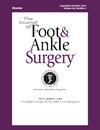Studies directly comparing Lisfranc injuries treated with primary arthrodesis or open reduction and internal fixation show no significant difference in return to sport and complications: A systematic review and meta-analysis
IF 1.3
4区 医学
Q2 Medicine
引用次数: 0
Abstract
Lisfranc injuries are common and can cause sport-ending morbidity. Management through primary arthrodesis (PA) or open reduction and internal fixation (ORIF) is a subject of debate.
PubMed, EMBASE, and the Web of Science databases were queried for studies assessing return to sport (RTS) outcomes following treatment of Lisfranc injuries with PA or ORIF. RTS rates, time to RTS, and complication rates were assessed. Maximum likelihood random-effects models were created based on comparative studies to evaluate differences in RTS and complication rates with odds ratios representing pooled estimates. Heterogeneity of return to sport outcomes was explored with sub-analysis of athlete level (non-elite vs. elite) and type of fixation.
Across 23 studies, 603 Lisfranc injuries were identified; 498 underwent ORIF and 105 received PA. Return to sport ranged from 65 to 100 % in ORIF subjects and 67-100 % of PA subjects. Meta-analysis of comparative studies reveals no significant difference in likelihood of RTS or complications (p = 0.44 I2=26 %; p = 0.93 I2=0 %, respectively). RTS times range from 8 to 30 weeks for ORIF and 19.7-28.5 weeks for PA.
Studies assessing RTS following ORIF and PA for Lisfranc injuries are heterogeneous, yet pooled data from comparative evidence suggests no significant difference in likelihood of RTS or complications. PA and ORIF have the potential for successful RTS though further prospective randomized studies are needed to better counsel athletes regarding the ideal surgical management for patient goals.
直接比较原发性关节融合术或切开复位内固定治疗的Lisfranc损伤的研究显示,在运动恢复和并发症方面没有显著差异:系统回顾和荟萃分析。
Lisfranc损伤是常见的,可导致运动结束的发病率。通过初级关节融合术(PA)或切开复位内固定(ORIF)进行治疗是一个有争议的话题。对PubMed、EMBASE和Web of Science数据库进行了查询,以评估使用PA或ORIF治疗Lisfranc损伤后恢复运动(RTS)的结果。评估RTS率、RTS时间和并发症发生率。最大似然随机效应模型建立在比较研究的基础上,以比值比代表汇总估计来评估RTS和并发症发生率的差异。通过对运动员水平(非精英与精英)和固定类型的亚分析,探讨了运动结果回归的异质性。在23项研究中,确定了603例Lisfranc损伤;498例行ORIF, 105例行PA。ORIF受试者的运动恢复率为65-100%,PA受试者的运动恢复率为67-100%。比较研究的荟萃分析显示RTS或并发症的可能性无显著差异(p=0.44 I2=26%;p=0.93 I2=0%)。ORIF的RTS时间为8-30周,PA为19.7-28.5周。评估ORIF和PA治疗Lisfranc损伤后RTS的研究是异质的,但来自比较证据的汇总数据表明,RTS或并发症的可能性没有显著差异。PA和ORIF具有成功RTS的潜力,但需要进一步的前瞻性随机研究来更好地为运动员提供关于理想手术治疗患者目标的建议。证据等级:四级。
本文章由计算机程序翻译,如有差异,请以英文原文为准。
求助全文
约1分钟内获得全文
求助全文
来源期刊

Journal of Foot & Ankle Surgery
ORTHOPEDICS-SURGERY
CiteScore
2.30
自引率
7.70%
发文量
234
审稿时长
29.8 weeks
期刊介绍:
The Journal of Foot & Ankle Surgery is the leading source for original, clinically-focused articles on the surgical and medical management of the foot and ankle. Each bi-monthly, peer-reviewed issue addresses relevant topics to the profession, such as: adult reconstruction of the forefoot; adult reconstruction of the hindfoot and ankle; diabetes; medicine/rheumatology; pediatrics; research; sports medicine; trauma; and tumors.
 求助内容:
求助内容: 应助结果提醒方式:
应助结果提醒方式:


